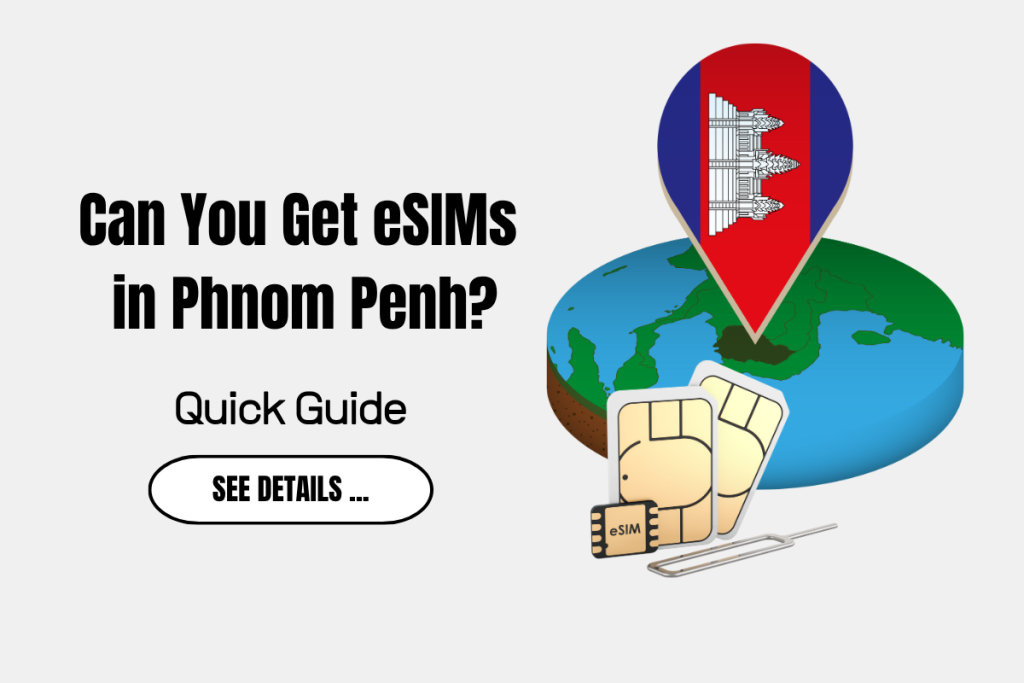Phnom Penh has become a hotspot for international visitors seeking convenient mobile connectivity. The city attracts tourists exploring temples and markets, remote workers enjoying affordable living costs, and business travelers attending regional conferences. Most visitors immediately ask: “Can I get an eSIM in Phnom Penh?” The answer is yes—through both local providers and international platforms. eSIM technology eliminates the hassles of finding telecom shops, waiting in lines, and dealing with language barriers by letting you activate mobile data instantly through a simple QR code scan.

I. What Is an eSIM?
eSIM technology eliminates the need for physical SIM cards, making travel connectivity simpler than ever. An eSIM is a digital SIM card embedded in your smartphone—no. No plastic chip required. Instead of inserting a card, you scan a QR code that downloads your mobile plan directly to your device.
Key benefits for Phnom Penh travelers:
- Instant activation without visiting physical stores
- Pre-arrival setup so you’re connected upon landing
- Dual SIM capability that keeps your home number active while using Cambodian data
- Works with iPhone XS+, Samsung S20+, Google Pixel 4+, and most modern flagships
II. Cambodian Telecom eSIM Support
Cambodia’s major telecoms have varying levels of eSIM support, so knowing which providers work is essential.
Smart Axiata leads Cambodia’s eSIM adoption with full support for both postpaid subscribers and tourist prepaid users. Their network covers Phnom Penh comprehensively with reliable 4G speeds throughout the city and extending to Siem Reap, Sihanoukville, and other major destinations.
Cellcard (Mobitel) offers eSIM services in Phnom Penh and Siem Reap. As Cambodia’s oldest mobile operator, they provide solid coverage and competitive tourist plans through both physical stores and their mobile app.
Metfone does not support eSIM as of 2024—physical SIM only.
International platforms like Cambodiaesim.com deliver Cambodia plans with instant QR code delivery, partnering with local networks while handling everything digitally.
III. Where to Get Your eSIM in Phnom Penh
You have two main options for obtaining an eSIM in Cambodia’s capital: local stores or online platforms.
Local Telecom Stores
Smart Axiata’s flagship store on Monivong Boulevard and Cellcard’s main office near Central Market offer in-person eSIM activation. Staff speak English, help verify phone compatibility, and scan QR codes for you if needed. Bring your passport for tourist verification and ensure your phone is unlocked. The process takes 15-30 minutes, including registration and activation.
Best for: Travelers who prefer face-to-face assistance or want to compare multiple plan options with staff guidance.
Online eSIM Providers
Platforms like Airalo, Nomad, and CambodiaESIM.com let you purchase online, receive a QR code via email within minutes, and activate anywhere with WiFi. You can complete the entire purchase before leaving home, ensuring connectivity immediately upon landing.
Best for: Travelers who value speed and convenience, or those arriving outside store hours.
IV. Best eSIM Plans for Phnom Penh Visitors
Pricing and data allowances vary across providers, so choosing the right plan depends on your trip length and usage needs.
Short Trips (3-7 Days)
- Smart Axiata Tourist eSIM: $5-7 for 4-5GB (7 days) — covers maps, messaging, social media
- Airalo SmartCambodia: $4.50-7 for 1-3GB (7 days) — ideal for minimal users
Medium Stays (7-15 Days)
- Cellcard Visitor eSIM: $8-10 for 8-10GB (14 days) — supports photo uploads, video calls
- Nomad Cambodia: $10-15 for 5-7GB (15 days) — good for extended exploration
Extended Stays (30+ Days)
- Smart Axiata Monthly: $10-12 for 10-15GB (30 days) — best value for digital nomads
- Cellcard 30-Day Plans: $12 for 15GB — substantial data for remote work
Note: Online platforms offer faster access, while local stores may provide slightly better rates and personalized assistance.
V. How to activate your eSIM
Setting up your Cambodian eSIM takes just a few minutes regardless of which provider you choose.
- Choose your provider based on trip length and data needs
- Verify compatibility — ensure your phone is eSIM-compatible and carrier-unlocked
- Purchase your plan online or at local stores with passport
- Receive QR code via email (2-5 minutes online) or in-store immediately
- Install the eSIM:
- Go to Settings → Cellular/Mobile Data → Add eSIM
- Scan the QR code
- Set as primary/secondary line
- Enable data roaming
- Connect — your phone finds the network within 30-60 seconds
The entire process takes 5-10 minutes for online eSIMs or 20-30 minutes including store registration.
VI. Who Benefits from Phnom Penh eSIMs?
Different types of travelers find eSIMs valuable for different reasons.
Short-term tourists activate eSIMs before departure and land on the internet for immediate Grab rides and Google Maps directions to hotels.
Business travelers require instant email access and video calls benefit from pre-arrival activation that ensures connectivity the moment they clear customs.
Remote workers and digital nomads use eSIMs to maintain local Cambodian data for cafes and coworking spaces while keeping their home number active for client calls and banking verification.
Multi-country travelers exploring Southeast Asia appreciate eSIM flexibility—add and Cambodia now, switching to Thailand or Vietnam later, all without juggling physical SIM cards.
VII. FAQs
Can I get prepaid eSIM as a tourist?
Yes, both Smart Axiata and Cellcard offer prepaid eSIM plans specifically designed for visitors. No long-term contract or local address required—just passport verification.
Are there eSIM kiosks at Phnom Penh airport?
No dedicated eSIM kiosks exist as of 2024. However, you can purchase it online before landing for instant activation upon arrival.
What’s network coverage like?
Smart Axiata and Cellcard both provide excellent 4G coverage throughout Phnom Penh’s urban areas, major highways, and tourist destinations. Rural areas may experience slower speeds.